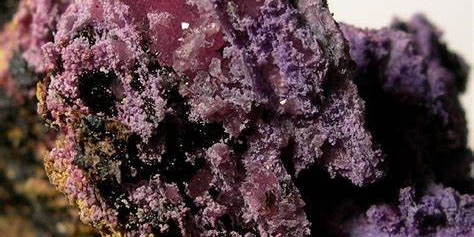Phosphosiderite
Phosphosiderite is a rare and beautiful mineral known for its stunning shades of purple and violet, often with hints of pink or lavender. It is a relatively lesser-known gemstone that belongs to the phosphate group of minerals, specifically a hydrated iron phosphate. Phosphosiderite is not only appreciated for its striking color but also for its metaphysical properties.

Characteristics of Phosphosiderite:
- Color:
- Phosphosiderite’s most prominent feature is its vivid purple to violet color, sometimes with pinkish or lavender undertones. The color can range from soft, pastel shades to deeper, more intense purple hues, depending on the specific sample.
- Composition:
- It is composed of hydrated iron phosphate, with the chemical formula Fe3(PO4)2(OH)3·3H2O. The iron content is responsible for its distinct colors and unique appearance.
- Transparency:
- Generally translucent to opaque, depending on the quality and clarity of the individual specimen.
- Hardness:
- Phosphosiderite is relatively soft with a hardness of 4.5 to 5 on the Mohs scale, making it less suitable for regular wear in jewelry but excellent for collectors and ornamental pieces.
- Luster:
- It has a vitreous to pearly luster, giving it a subtle shine when polished.
Formation:
Phosphosiderite forms in secondary deposits in oxidized iron-rich environments, often in hydrothermal veins or as part of the weathering process of iron ore deposits. It can be found in association with other minerals such as limonite, hematite, and goethite.
Phosphosiderite crystals are typically short prismatic or tabular, and the mineral can also occur in massive or botryoidal (grape-like) forms.
Geographic Locations:
- Brazil: One of the most well-known sources of phosphosiderite.
- Chile: Another location where phosphosiderite has been found, though it is rarer.
- Australia: Known to have deposits of this rare mineral as well.
- Germany: Some older sources of phosphosiderite are found here, but it is now quite scarce.
Uses:
- Jewelry:
- Due to its relatively soft nature, phosphosiderite is not commonly used in jewelry, but it may be cut into cabochons, beads, or small ornamental pieces. It is ideal for decorative purposes or collector’s items.
- Mineral Specimens:
- Phosphosiderite is a favorite among mineral collectors due to its unique color and rarity. High-quality specimens with good clarity and vibrant color are highly valued.
- Metaphysical Properties:
- Emotional Healing: Phosphosiderite is believed to be a stone of emotional healing, helping to alleviate stress, anxiety, and emotional blockages. It is thought to bring comfort and relief in times of emotional turmoil.
- Spiritual Growth: This mineral is often associated with enhancing intuition and psychic abilities. It is believed to help open the third-eye chakra, promoting a deeper connection to spiritual insights.
- Cleansing: It is also considered to have purifying properties, helping to cleanse the aura and remove negative energies.
Care and Maintenance:
- Cleaning:
- Due to its relatively soft nature, phosphosiderite should be cleaned gently with a soft cloth and warm, soapy water. Avoid using harsh chemicals, ultrasonic cleaners, or steam cleaning methods.
- Handling:
- Since it has a lower hardness, phosphosiderite should be handled with care to avoid scratching or chipping. It is best suited for display in a collection rather than for daily wear.
- Storage:
- Store separately from harder gemstones to prevent scratching. If used in jewelry, ensure it is set in a protective setting to shield it from damage.
Rarity and Value:
Phosphosiderite is considered a rare gemstone, and high-quality specimens with vivid color and clarity can be quite valuable to collectors and mineral enthusiasts. Its relative softness and scarcity in the market contribute to its status as a unique and sought-after mineral, though it is not commonly found in mainstream jewelry.
Leave a Reply
Want to join the discussion?Feel free to contribute!